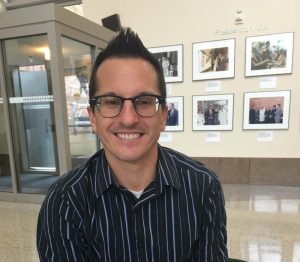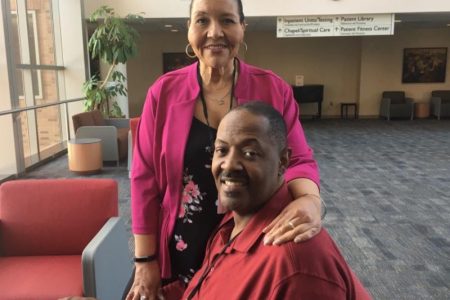Matthew and wife, Dana, both worked two jobs until recently. He has always been too proud and independent to need or ask for help, Dana explains. But his journey from his home near Baltimore to the National Institutes of Health to enroll in a treatment study tipped the scales of challenges and they reached out to Friends.
Matthew was diagnosed with Non-Hodgkins Lymphoma in 2015 and after numerous intense treatments including a stem cell transplant and Car-T cell treatment, his cancer returned.
“My biggest thing was getting him here [to the NIH]. Everything else was secondary to getting him that best shot but I couldn’t throw enough balls in the air. I had been dealing with so much for so long, I just didn’t have any answers,” Dana explained.
Friends at NIH stepped in to help with car payments, so Matthew and Dana could drive to the NIH. Matthew works as a fueling worker at the airport, when he’s able, and in his own landscaping business. Dana took family leave to be his caregiver and their regular income was suspended.
Dana is emphatic that Friends’ supporters know our help is far greater than paying a few bills. “It is allowing people the peace of mind to be here with their loved ones, to be able to facilitate support for them and to have comfort to know that when you go home, your lights will be on,” she added.

Dr. Christopher Melani, National Cancer Institute
Matthew’s physician, Dr. Christopher Melani, who helped write the protocol, says this study is unique because it combines five cancer-combating agents for the first time. The agents have been used to treat lymphomas, but generally only one or two at a time.
“The goal of the combination therapy is to drive the cancer into deeper remission and make that response last much longer,” Dr. Melani explained.
Twenty-six patients are enrolled in the study that began a year ago, Dr. Melani notes. All the patients had failed other treatments. The protocol attempts to combat potential side effects by giving the agents like chemotherapy – hitting the cancer hard with breaks between cycles. While it is too early to cite results, the patient in the protocol who now is the longest in remission, is nine months out of treatment. Dr. Melani finds this encouraging.





